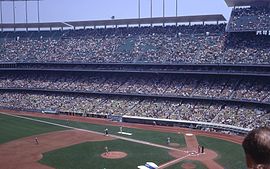Sports season
The 1967 Major League Baseball season was contested from April 10 to October 12, 1967. The St. Louis Cardinals defeated the Boston Red Sox four games to three in the World Series, which was the first World Series appearance for the Red Sox in 21 years. Following the season, the Kansas City Athletics relocated to Oakland.
The season was filled with historic seasons from multiple players. Carl Yastrzemski of the Boston Red Sox had tied for the most home runs in MLB with Harmon Killebrew, giving him the elusive triple crown. He led the American League in batting average (.326), home runs due to the tie with Killebrew (44) and runs batted in (121) (This feat would not be accomplished again until Miguel Cabrera earned the triple crown in 2012 with the Detroit Tigers).[1] Yastrzemski also won the AL MVP and led the Red Sox to the AL pennant for the first time in two decades. They would ultimately lose to the St. Louis Cardinals 7–2 in Game 7 of the World Series.[2]
The Cardinals had standout players as well, with first baseman Orlando Cepeda becoming the first unanimously voted NL MVP. Cepeda finished the season with 25 home runs, 111 RBIs and a .325 batting average. He did however, struggle in the World Series, hitting only .103 with one RBI.[3]
MLB statistical leaders
1 American League Triple Crown Batting Winner
Television coverage
NBC was the exclusive national TV broadcaster of MLB, airing the weekend Game of the Week, the All-Star Game, and the World Series.
